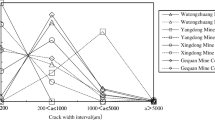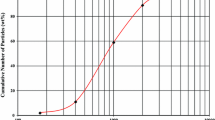Abstract
A grout based on portland cement, Class F fly ash, and bentonite clay was developed as part of the closure system of shallow subsurface structures for disposal of low-activity radioactive wastes. Heat output, volume change, and compressive strength of the sealing grout were monitored with time, at elevated temperature, and in physical models, to determine if this closure grout could maintain adequate volume stability and other required physical properties in the internal environment of the disposal structure.
To determine if contact with an alkaline liquid waste would cause chemical deterioration of the sealing grout, cured specimens were immersed in a liquid waste simulant containing high concentrations of sodium and aluminum salts. Over a period of 21 days at 60 °C, specimens increased in mass without significant changes in volume. X-ray diffraction of reacted specimens revealed crystallization of sodium aluminum silicate hydrate.
The new phase has an X-ray diffraction pattern similar to that of the commercial syntheticzeolite, Losod. Scanning electron microscopy used with X-ray fluorescence showed that clusters of this phase had formed in grout pores, to increase grout density and decrease its effective porosity. The testing was repeated at 100 °C for 5 days using a simulant containing sodium hydroxide and aluminum nitrate and the results were similar. Physical and chemical tests collectively indicate acceptable performance of this grout as a seal-system component.
Similar content being viewed by others
References
L.D. Wakeley, E.W. McDaniel, J. Voogd, J.J. Ernzen in Fourth CANMET/ACI International Conference on Fly Ash Silica Fume, Slag and Natural Pozzolans in Concrete, Supplementary Papers, (American Concrete Institute, Detroit, MI, 1992), pp. 1–14.
L.D. Wakeley and J.J. Ernzen in Advanced Cementitious Systems: Mechanisms and Properties, edited by F. P. Glasser et al. (Mater. Res. Soc. Proc. 245, Pittsburgh, PA, 1992), pp. 117–122.
L.D. Wakeley and J.J. Ernzen, Grout for Closure of the Demonstration Vault at the DOE Hanford Facility, (U.S. Army Engineer Waterways Experiment Station, Vicksburg, MS, 1992, Technical Report SL-92-21), 25 pp.
Amer. Soc. for Testing and Materials, Standard Test Methods for Chemical Analysis of Hydraulic Cement, Designation: C 114–88, 1992.
R.M. Barrer, Hydrothermal Chemistry of Zeolites, (Academic Press, New York, 1982), p. 230.
M.J. Grutzeck, Air Force Office of Scientific Research Report, PSU-AFOSR-91, 1991.
W. Sieber and W.M. Meir, Helv. Chem. Acta 57, 1533 (1974).
Author information
Authors and Affiliations
Rights and permissions
About this article
Cite this article
Malone, P.G., Wakeley, L.D., Burkes, J.P. et al. Performance of Cement-Basedseal Systemcomponents Inawaste Disposal Environment. MRS Online Proceedings Library 370, 191–198 (1994). https://doi.org/10.1557/PROC-370-191
Published:
Issue Date:
DOI: https://doi.org/10.1557/PROC-370-191




